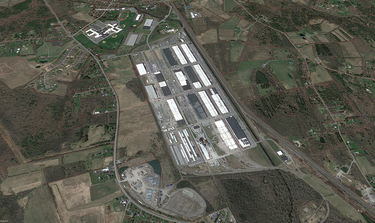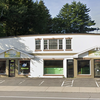Court lowers Northeastern Industrial Park assessment over 40%, Guilderland appeals
— From Google Earth
After filing four tax certiorari proceedings against the town of Guilderland in as many years, the Northeastern Industrial Park at the start of this year received notice of a favorable outcome in its first Article 7 filing, from 2019. The decision lowered the industrial park’s assessed value for that year from from $72.8 million to $43.2 million. Guilderland has already filed an appeal seeking to reverse or modify the lower court’s ruling.
GUILDERLAND — At the start of the new year, an Albany County court knocked close to $30 million off the Northeastern Industrial Park’s 2019 assessment. The outcome was quickly disputed by the town of Guilderland, which filed a challenge to the decision just under a month after it was handed down.
In her Jan. 3 ruling, Justice Margaret Walsh lowered the collective assessed values of five parcels in the industrial park, once the home of an Army storehouse and now the site of over 20 industrial-sized buildings in one of the few remaining rural-suburban areas in town, from $72.8 million to $43.2 million.
Northeastern was seeking an assessment of $31 million.
In the wake of Guilderland’s 2019 town-wide property revaluation, the town has faced a series of assessment challenges, largely from commercial properties, that has left particularly the Guilderland school district vulnerable. Last summer, the district drained its roughly $932,000 Tax Certiorari Reserve, took another $430,000 from its unrestricted fund balance, and then had to borrow $1.5 million to refund tax payments.
Before the 2019 revaluation, Guilderland hadn’t revalued its properties town-wide since 2005. Guilderland Supervisor Peter Barber told The Enterprise in 2020, “The goal was ultimately to more fairly and equitably spread the tax burden so residential [property owners] wouldn’t be subsidizing commercial. We did that.”
In her decision on Northeastern, Walsh noted Northeastern had commenced “two tax certiorari proceedings to challenge the 2019 and 2020 tax assessments,” but the “parties agreed that the 2019 matter [would] proceed to trial with the understanding” that, because of the state’s real property tax laws, the industrial park’s 2020 assessed value was contingent the outcome of its 2019 assessment trial.
The industrial park’s July 2022 tax lawsuit marked the fourth time in as many years it had filed a tax certiorari against the town.
Arguments in Northeastern’s 2019 Article 7 petition were made in July 2021; however, a few months after each side had made their final pleas, the town requested the trial be reopened so it could enter into evidence the October 2021 sale of properties at three addresses: 8, 21, and 22 Northeastern Industrial Park.
The three properties, which total approximately 20 acres, were sold for $30 million. The parcels were not part of the current litigation, but the town said it would offer evidence that the sale affected the “methodology and opinion of value” of industrial parks’ appraiser.
Walsh granted the town’s request to reopen the case, leading to each side’s attempt to strike from the record the other’s appraisal of the over-500-acre property. Neither would be wholly successful in their endeavor.
Town appeals
The town in its Feb. 2 Notice of Appeal filed with the Third Appellate Division of the state Supreme Court, stated it was challenging the lower court’s ruling on the basis of three issues:
— Walsh had “erroneously” denied the town’s motion to toss Northeastern’s appraisal because it valued itself as a single entity; Guilderland argued the industrial park should come up with individual appraisals for each of the five parcels involved in the lawsuit.
The town also argued the appraisal was based on “extraordinary assumptions and hypothetical conditions” and relied on national survey data to come up with estimates of future repair costs, while the appraiser also neglected to include as part of his estimate hundreds of undeveloped acres on the site.
The industrial park’s appraiser used a method of assessment that valued the five individual parcels as a “as a single unified property,” which Northeastern argued was “the more persuasive methodology because the most feasible economic and physical use of the parcels at issue is as a single industrial park.”
Guilderland claimed its appraisers’ methodology valuing the five parcels individually was more appropriate because there were sites on the stand-alone parcels that were being advertised for “build-to-suit projects.”
The town also argued a potential future tenant could subdivide the land, noting the $30 million sale of three buildings in the park, while pointing out that “individual buildings have different uses and are occupied by different tenants,” Walsh wrote.
Walsh sided with the industrial park on valuation methodology.
The five parcels “are operated as an integrated property and should be valued as a whole,” which wasn’t the case with the $30 million three-building deal, Walsh wrote, because the five parcels “at issue have not been sold and are subject to a common deed,” in addition to being “subject to integrated roadways, rail tracks, a private utility infrastructure, and a single entrance to the park without the existence of any easements governing the use of the tax parcels”
The area included as part of Northeastern’s lawsuit constitutes about 521 of the industrial park’s 650 total acres. But about 18 percent, approximately 93 acres, of those 521 acres are considered wetlands, about 50 acres are either road or railway, while another 26 acres are “encumbered” by an environmental easement, according to the park’s appraiser.
In her decision, Walsh wrote that the town’s appraisals for two specific parcels included advertisements from Northeastern “concerning potential development of land on the Subject Property.”
The largest of the three parcels that makes up 2 Van Buren Boulevard, which itself accounts for about 500 of the total 521 acres in Northeastern’s lawsuit, is a 290-acre plot that contains 26 acres of land under an easement with the state’s Department of Environmental Conservation in addition to another 50 considered wetlands, according to the town’s appraisal.
The other parcel is 210 acres of which 48 were determined by the town’s appraiser to be excess, which is “defined as land that is not needed to serve or support the existing use.” And was determined by the town’s appraiser to have 7 acres “impacted by wetlands.”
The town appraisal estimated the 290-acre parcel to have 189 excess acres.
The town-included advertisements were meant to identify the excess acreage as land that “could be separated and sold separately” as part of some future deal, which meant it had some kind of value, about $4.77 million, according to the town’s appraiser.
Walsh wrote the town’s “excess land theory is based on speculation concerning a hypothetical future use of the Subject Property,” which had no bearing on the matter at hand, the acreage’s 2019 assessment, because the land’s value “is expressly limited to an assessment of the condition of the property according to its state on the taxable status date.”
The two parcels and their 500 acres had a 2019 assessed value of nearly $58 million, which the town’s appraisal said should have been about $49 million and Northeastern countered with $23.7 million. Walsh landed on $37.6 million;
— In calculating Northeastern’s 2019 assessessed value, Walsh had “erroneously” included as part of her analysis questionable data from the industrial park’s appraisal; and
— As she was including the shoddy data to inform her calculation of Northeastern’s 2019 assessed value, Walsh “incorrectly rejected” a “comparable sales analysis” submitted as part of the town’s appraisal.
In its Feb. 2 informational filing, Guilderland argued that the figures used by Northeastern’s appraiser to arrive at a nearly $30 million decline in the assessment were the same reason why the park’s appraisal needed to be tossed.
The methodology used to determine the subject property’s “potential gross income, reimbursement revenue, gross up for taxes, vacancy analysis, expense reimbursements, and certain operating costs” had been inconsistent, speculative, and contradictory, the town argued.
The town further claimed the appraisal should be struck from the record because it used “certain ‘forecasted’ amounts” as part of its valuation methodology; rather than looking at the actual monthly leases paid by park tenants.
Walsh for the most part appeared to disagree with the town’s sentiment, writing that Northeastern’s report contained just enough information about valuation methodologies to meet the “minimal threshold burden” necessary for showing there is a dispute over the assessment.
The town, according to Walsh, also claimed a report from engineer Daniel Hershberg estimating future infrastructure costs in the industrial park were inadmissible because they relied on a cost index published a year after the property’s taxable status date. Hershberg’s report also failed to include a specific reference to that status date; the town indicated the estimate was not accurate as of March 1, 2019, Walsh wrote.
Earlier filings
During the July 2021 trial, Hershberg, who Walsh wrote had 60 years of engineering experience at the time, said it was his opinion that the year-over-year increases associated with a project’s cost would be “de minimis,” or too trivial to merit consideration.
The town also argued that Hershberg’s engineering report failed to include documentary support of his cost estimates, which the town asserted in an earlier filing was a “derogation” of a trial court rule that “requires that the facts, figures, and calculations supporting the ultimate opinion of value be included in the appraisal report, otherwise it will be stricken.”
Guilderland in earlier filings asserted that, historically, the money set aside for future infrastructure upkeep in the park was greater than the estimated repair reserves calculated by Hershberg and “greater than those reviewed by [the town’s] appraiser in other assignments.
The Jan. 3 decision from Walsh stated the engineering cost report from Hershberg had been “incorporated into [Northeastern’s] appraisal.”
Walsh then wrote that “the use of an incorrect valuation date need not result in the striking of an appraisal report but may be cured by the expert’s trial testimony,” which was the case for Hershberg during the July 2021 trial date.



